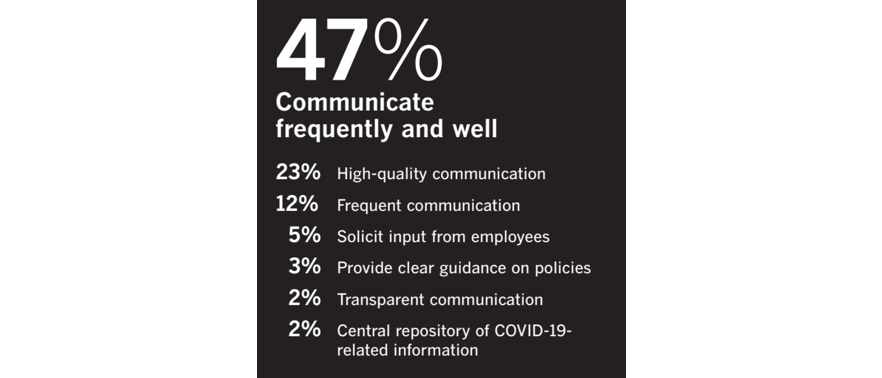When I speak to HR leaders at large companies and ask them what their most urgent priority is these days, they usually say the management of remote work. Before the pandemic, about 15% of US employees worked remotely. Now, half of US workers are suddenly doing their work away from the office. What's more, three quarters of financial executives plan to shift at least some of their workforces to to full-time remote work after the pandemic subsides. They are probably not alone. The economy suddenly got very remote, looks likely to stay quite remote for a long time, and desperately needs solutions to make remote work work for everyone, remotely.
Survey Says... Communicate
To surface best practices, I've been speaking to HR leaders about their day-to-day. Together with Josh Bersin and the CEO of Waggl, Michael Papay, CultureX has also launched an open-text survey asking HR leaders how they are responding to COVID. The Pulse of HR survey has garnered over 1,200 responses from HR professionals. Because it is an open-text survey, respondents can write what is most important to them in their own words, rather than responding to our cues. CultureX's AI then analyzes the results with a very high rate of granularity (into COVID-specific topics like "organize virtual social activities") and accuracy (90%+).
So what is working, according to the 451 HR professionals who answered the question "What is the most impactful thing your organization has done to support employees’ transition to remote work"? If you want to read the full report of the study, I encourage you to check out the recent article I published with Don and Josh Bersin, available for free on MIT Sloan Management Review. In this post, I wanted to focus on perhaps the single biggest takeaway from the survey: communication. When citing what works, 47% of respondents mentioned communication. CultureX AI identified five characteristics of the communication respondents discussed: frequent, transparent, two-way, easy to navigate, and consistent.
Frequent: Frequency, specifically, was cited by 10% of respondents, who prefer daily or at least weekly updates from the CEO, preferably in the form of videos or webinars rather than email.
Transparent: Respondents appreciated when leaders explained their decision making process candidly and provided justification for their choices, rather than announcing new policies by decree.
Two-Way: Employees like to be heard, and forums like weekly pulse surveys, dedicated COVID email accounts, virtual town halls, and fireside chats proved successful in surfacing concerns. Some employers set up dedicated COVID response teams that matched specific concerns with the right person in the company to respond to them.
Easy to Navigate: Employees like centralized, accessible sources of information. It's less confusing, and more authoritative. Highly ranked resources included frequently asked questions (updated daily), virtual training resources on trending topics (such as managing virtual teams and leading online meetings), archived video messages from leaders, remote-work success stories from colleagues, and clearly stated guidelines on new HR policies.
Consistent: The most commonly cited obstacle to effective communication was inconsistency. When different messages come from different parts of the organization, it can create anxiety for employees and stall decision making necessary in a crisis. Middle managers and front-line leaders responsible for daily communication with employees need to ensure their message does not conflict with the top team's.

Communicating Effectively at a Startup
My conversations with HR leaders echoed these themes. I recently caught up with one of the first hires of a rapidly growing tech startup that now employs nearly 250 employees. Her Zoom background, a stately English manor's tea room. Mine, an underwater restaurant. What is remarkable about those 250 employees, though, is that almost all of them are remote, and they always have been. The startup is remote-first, meaning that their employees have had several years head start in wearing sweatpants to important meetings and choosing the funniest Zoom backgrounds.
Not only that, but they are very happy. The HR VP shared with me her company's employee net promotor score, and it was off the charts, even during COVID. It seemed that she was one of the HR cognoscenti who had figured out the secrets of successful remote work years before anyone even realized it was a big deal, and I was eager to learn her secrets.
Sure enough, the first pillar of the company's culture was communication. Frequent leadership checkins abounded, and the company had systems in place for informal, lateral social hours to encourage camaraderie. Alignment in communication was ensured through a rotating employee advisory council that sought out employee concerns and raised them to top management, and decisions were communicated consistently downstream. In this VP's own words, "togetherness activities" were her highest priority.
This "togetherness" fabric of frequent, transparent, bidirectional, navigable, and consistent communication enabled this startup to thrive while providing a fantastic environment for employees to work. But how would it work at a much larger company, where there can be ten levels between front-line employees and the CEO, rather than two or three, and senior management has to consider tens of thousands of diverse employee perspectives, rather than a couple hundred?

Scalable Communication Technology
As with many things, technology can provide the answer to scalability. In a small village (or a startup), it's possible to have conversations with all the villagers and sort out issues that way. In New York City or Tokyo (or Microsoft), it's impossible. So how do you find out who has what issue, and come up with an effective communication strategy to address them? If having a million conversations is off the table, you probably need technological help to communicate effectively with masses of employees.
One way to do this is through pulse surveys to employees. Pulse surveys can take three forms: multiple choice, free text, or hybrid. Multiple choice questions have the advantage of being very easy to analyze, but they risk missing the employee's true voice. If you ask the question, "Which of the following is the biggest issue to you: personal health worries or balancing work-life balance?" maybe the employee cares more about a third, unasked issue. Even if they select "work-life balance", they are still not giving any context about their problem. When senior management reads the results of the pulse survey, they may see that work-life balance is a big issue, but they won't know much more than that from the survey.
Free text captures the employee's voice with more fidelity, and offers richer insights. Employees can write exactly what is important to them, in their own words. Using this listening approach, you can make sure that you capture every answer that matters to employees, not just the ones you put on your list. This matters, especially when you are asking a large audience with a diverse range of concerns. You also learn a lot more from their words. If an employee writes, "My pet makes it difficult to concentrate during work", that is a different kind of issue than "My landlord is not renewing my lease and I have nowhere to work or live", although both of them might fall under the "Work-Life Balance" checkmark of the multiple choice survey. Free text does a better job of alerting you to to the important issues, because it surfaces employee's concerns on their own terms, and it also does a better job of explaining their context and giving you the building blocks for effective ways to communicate back. A free text pulse survey much more closely resembles an "automated conversation" than a multiple choice survey.
Then there is the hybrid survey. When you combine multiple choice, or Likert-Scale, questions, like "On a scale of 1 to 5, how well is remote work going for you?" with free text questions like "What about remote work is not working for you?" you can identify all of the good parts of free text surveys, but also get a sense of how predictive of desired outcomes various drivers are. For instance, you can see that employees who cite the topic "no work space at home" are almost certain to rate their remote work experience a "1" or a "2". This approach can identify the highest-impact pain points of remote work, and can also be used to inform communication approaches as well as decisions like who should return to the office first.
So what's the drawback of free text or hybrid surveys? Traditionally, they are very hard to make sense of at scale. They run into the same problems as having a million conversations: you need someone to read all of the answers. I was recently doing some work with a large client and I did some mental math... it would take someone a full year of working 9am to 9pm, every day, no weekends, no coffee breaks, just to read all of the free text responses from a single survey they administered. As one of the few people on earth who has actually spent years doing this– manually reading tens of thousands of employee reviews– I can assure you it is not the most fun job. And even if it were incredibly fun, it wouldn't be practical. If you read all the reviews, you still need to find some way to synthesize your findings and make sense of results, and by the time you've fininshed it would be time for a new survey, cruelly enough.
But again, the solution to scalability is technology. At CultureX and at MIT, we've spent years developing a way to accurately make sense of employee feedback at scale. Internally, a few advanced people analytics departments at large companies are also developing a similar approach to us. I won't go into the details of this technology in this COVID pulse, but it effectively solves this tricky problem.
Crucially, free text and hybrid surveys are most effective at scale. For villages, conversations should work. But the bigger you get, the more value free text surveys and analytics can add.

Communicating Effectively at Scale
Keeping in mind the best practices of COVID communication– frequent, transparent, bidirectional, easily navigable, and consistent– the challenges at scale are considerable. Senior Management needs ways to identify and understand the most pressing challenges many thousands of diverse employees face, craft transparent responses that ring of tailoring but are actually quite uniform and cover the most ground possible to ensure organizational alignment, and then frequently and effectively match responses with employees who have the issues. All of this is happening, by the way, in a rapidly changing, historically unpredictable landscape. But if accomplished, employees will feel like they are part of a two-way dialogue that addresses their concerns as they arise. Remote work will work, remotely.
Surfacing and Understanding Concerns
In a village before COVID, you could host a physical town hall to hear what the villagers were concerned about. But free text and hybrid surveys do a pretty good job of replicating this virtually at a large company with many more voices. Administering a very simple, five-minute survey to your employees can cover a large amount of ground. Simply ask for a few demographics– function, role level, location, gender, has children, and so forth– then ask a 1 to 5-point indicator about how well remote work is working. Finally, follow up with two simple free text questions: what is working about remote work, and what is not working?
At a large company, it would take a person a year to read through the results of this survey manually. But with new technology, you can accurately understand the survey results within a couple of hours. This five minute survey tells you a lot:
What the most pressing concerns in the company are
Senior management can see what the most important issues are, according to employees. This might not sound very revolutionary, but when compared to perhaps the most common survey method today- giving respondents a laundry list of issues and asking them to rate each on a one to five point scale– it is. If you ask respondents to rate issues on a point scale, not only do they frequently zone out, they also do not give an indicator of how important each issue is to them, only how well it is going. When employees proactively raise an issue, you can be sure it really matters to them.
Senior management can quickly see what is working best, and what needs to be addressed the most urgently. Using the hybrid survey approach, they can also identify the most powerful drivers of desirable and undesirable outcomes. This data can provide the building blocks of their strategy, revealing what to prioritize.
How concerns vary across the company
Using demographic data, you can also see which specific groups have specific concerns. Your communication strategy to employees in one country might be different to workers in another country, because they raise different issues.
Context about the issues
The great thing about free text is that you can gleam a lot of context about the issues by reading employee quotes. New natural language processing techniques allow you to see the distinctive terms and phrases that populate topics of interest (it's not keyword search so much as 'idea search', and it is highly accurate), allowing you to respond to employees using their own language and idioms. Correlation analysis allows you to see which topics are related to each other.
These approaches allow leaders to enter into much more of an authentic dialogue with employees, as they can learn how the issues live in the company, and the exact language employees use to speak about them.
Matching with concerned employees
After Senior Management has crafted its consistent, transparent communication strategy using building blocks from the survey, they can match key points with the exact audience who needs to hear about them. Being approached this way can make employees feel heard, especially if their own language is reflected in the company's response, and increase the bidirectional aspect of the exchange.
How results change over time
Pulse surveys are quick and easy to administer frequently. In a quickly changing environment, leaders can stay on top of what's working and what new issues need to be addressed, and maintain communication at a brisk cadence.

Here To Stay
Remote work looks likely to stay even after COVID goes away (good riddance, by the way). Even in traditional office environments at large companies, communication at scale is a significant challenge. By harnessing the power of the latest free text AI to understand and act on employees' words, corporate leaders can take village-like conversational communication to a new level. The upshot is a significantly more agile, effective, and even empathetic organizational structure, that more quickly and intelligently responds to new information from employees and creates an environment where they can thrive in tandem with the business.
John F. Kennedy once said, "In a crisis, beware of the danger– but recognize the opportunity". COVID has triggered a sudden transformation in the workplace unlike any since World War II. As corporate leaders look for ways to make remote work work for employees, they might also find a way to make work work better, period.
